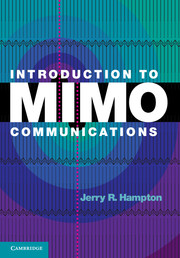Book contents
- Frontmatter
- Contents
- Preface
- 1 Overview of MIMO communications
- 2 The MIMO capacity formula
- 3 Applications of the MIMO capacity formula
- 4 RF propagation
- 5 MIMO channel models
- 6 Alamouti coding
- 7 Space-time coding
- 8 Spatial multiplexing
- 9 Broadband MIMO
- 10 Channel estimation
- 11 Practical MIMO examples
- Appendices
- References
- Index
11 - Practical MIMO examples
Published online by Cambridge University Press: 05 December 2013
- Frontmatter
- Contents
- Preface
- 1 Overview of MIMO communications
- 2 The MIMO capacity formula
- 3 Applications of the MIMO capacity formula
- 4 RF propagation
- 5 MIMO channel models
- 6 Alamouti coding
- 7 Space-time coding
- 8 Spatial multiplexing
- 9 Broadband MIMO
- 10 Channel estimation
- 11 Practical MIMO examples
- Appendices
- References
- Index
Summary
Now that the basic concepts of MIMO communications have been introduced, we conclude the book with a chapter that describes how those concepts are applied in real-world wireless communications systems. For this purpose, we focus on two popular wireless families of standards, WiFi and LTE/LTE-advanced, which are used extensively for wireless LAN applications and conventional cellular communications, respectively. Although these communication standards are extremely complex, we focus primarily on the MIMO aspects of these technologies.
WiFi
WiFi is a virtually ubiquitous wireless technology that is designed to allow electronic devices to exchange data wirelessly at rates ranging from 1 Mbps to as much as 600 Mbps over distances of typically 10s to 100s of feet. The most common application of WiFi technology today is the use of wireless routers in homes and businesses for the purpose of enabling computers, cellular phones, and a growing list of personal wireless devices to connect to the Internet without cables. The version of WiFi that employs MIMO is defined by the IEEE 802.11 n standard, which is the latest in a series of amendments to the original 802.11 standard that was developed in the late 1990s. The current version of the 802.11n standard at the time of this writing is called IEEE 802.11n-2009, which was published in October 2009. The information in this section is primarily gleaned from that standard [77].
- Type
- Chapter
- Information
- Introduction to MIMO Communications , pp. 232 - 263Publisher: Cambridge University PressPrint publication year: 2013



